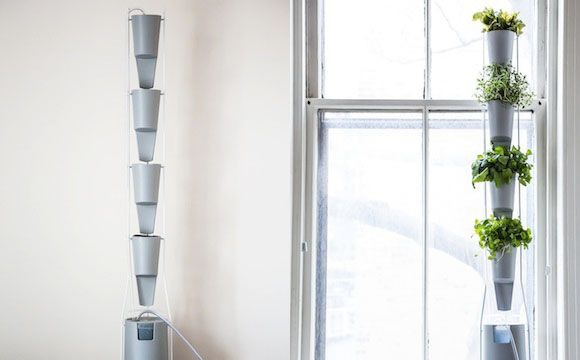We're sitting down with our favorite writers and cooks to talk about their upcoming cookbooks, their best food memories, and just about anything else.
Today: We chat with Greg Graft of Grateful Greens about urban farming, keeping herbs in your kitchen, and kale salad.

Greg Graft turned from professional chef to urban farmer, turning an old warehouse in downtown Louisville into a hydroponic urban garden and inspiring a new wave of urban growing initiatives in his home city. His company, Grateful Greens, provides baby plants for WindowFarms' hydroponic indoor gardens (that you can find in our shop right now!). Greg's produce has been featured on local chefs’ menus at The James Beard House in New York City and served at the Kentucky State Ball for the 2009 presidential inauguration in Washington D.C. We were lucky enough to pick his brain about the current state of urban gardening, his trasition from chef to farmer, and his love for year-round salads.
What inspired your transition from chef to hydroponic farmer? What was the greatest challenge in moving from preparing food to growing it?
When I worked in a restaurant I always really enjoyed visiting with our purveyors -- we had all kinds of farmers bring in all kinds of produce, mushrooms, you name it. It was fun to chat with them. Eventually, our chef gave me a plot behind the restaurant to begin growing produce; we started with herbs, lettuces, peppers, tomatoes, and edible flowers. I had a lot of fun spending time at work trimming herbs in the little 75x15-foot garden.
My wife's aunt had property near our home, and was willing to let me use the property to grow some stuff. In the spring of 1998 I planted our first seeds: squash, zucchini, corn, basil, and other things I knew we could bring into the restaurant or sell to local produce companies. After two years, I met someone who had an industrial warehouse in downtown Louisville and wanted to start an urban farming initiative. Because of environmental factors that prohibited us from planting in the soil, we decided on hydroponics. We started with edible flowers, micro greens, pea shoots -- things that were not very common in Louisville in the late '90s!
How do you see the urban farming landscape changing in U.S. cities?
There are so many local entrepreneurs looking for rooftop gardens or small hydroponic greenhouses. In the last eight weeks, two people who are contemplating indoor gardening have approached me. And in cities, people are looking to grow vertically to make the most of small spaces.
On a larger scale, the whole organic side of things seems to be trumped by buying local, knowing your grower, and knowing exactly where your food is coming from. Local farmers markets are popping up everywhere, and traditional markets are seeing less business because more people are moving toward local growers. In cities, this high demand for local produce is pushing people to explore urban farming.
Tell us about your favorite crop and your favorite way to prepare it.
I love making kale salad! We just massage a simple olive oil and vinegar dressing into the leaves.
What do you think is most important for home cooks to know about growing herbs and other plants in their own kitchens?
Don't give up -- it's trial and error!
It's important to remember that you're trying to imitate mother nature inside your home. These are the three most important factors:
1. Adequate lighting. Herbs and lettuces especially need a decent amount of light; otherwise, they will "stretch" too much and appear elongated. If you're just snipping them for your own kitchen, though, it doesn't matter what they look like!
2. Good air circulation. If you're in a stagnant space, the plant does not start out very healthy. In the presence of an oscillating fan, the plan will strengthen itself -- it will build a stronger stem and a better root system. Otherwise it will get leggy and have a tendency to fall over -- it may not stay very healthy, the root system might get stretched.
3. Watch your humidity -- most houses may be a little bit dry. (Windowfarms units water frequently so this isn't an issue). High humidity levels can stunt the growth of plants. It can clog the stemata -- sort of like the plant's pores -- which can keep it from growing. You don't want humidity over 65% (again, a fan can help here). Plant also keeps CO2 levels up.
Has your career shift changed the way you cook at home?
Yes -- and it keeps evolving. When I first started, and I was still working at the restaurant, I didn't eat as many greens as you think I would -- only some salads and herbs. Over the last 3-4 years, that has changed quite a bit. One of my favorite things to take home are salad greens for a simple salad. It depends on the season, but now we are eating a lot of kale and chard and beet greens -- I like spicy arugula, cress, etc. And we always incorporate lots of produce from local growers into our meals!

See what other Food52 readers are saying.